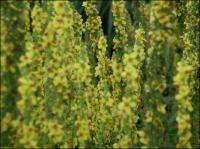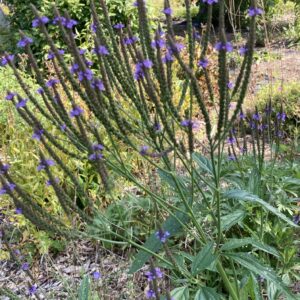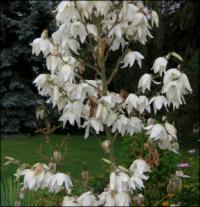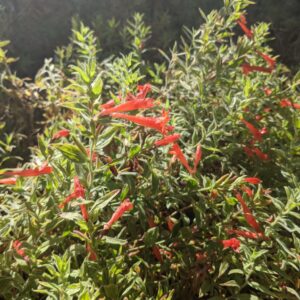Drought, Xeric & Dry Soil Plants
Showing 129–132 of 132 results
-
Verbascum nigrum Dark mullein Z 4-9
June to October (if deadheaded) canary yellow, occasionally ivory, spikes with purple stamens.
June to October (if deadheaded) canary yellow, occasionally ivory, spikes with purple stamens.
Size: 36" x 24"
Care: Sun in moist well-drained to well-drained soil - self-seeder. Drought tolerant.
Native: Europe to SiberiaVerbascum was named by the Roman Pliny who said they attracted moths, calling them Moth mulleins. Cultivated in gardens as long ago as Medieval times. Favorite plant in Elizabethan cottage gardens in the 1500’s. Grown in the Eichstätt Garden, the garden of Johann Konrad von Gemmingen, prince bishop of Eichstätt in Bavaria, c. 1600. Described by Parkinson in 1629 as: “a stalke whereon stand many golden flowers with the like purple threads in the middle.”
-
Verbena hastata Blue vervain, Simpler’s joy Z 3-9
Bright purplish-blue candelabra-like spikes from July to September
Bright purplish-blue candelabra-like spikes from July to September
Size: 2-4’ x 2’
Care: sun to part shade in moist or moist well-drained soil
Native: eastern 2/3rds of No. America, Wisconsin native
Wildlife Value: Cardinals & Sparrows eat the seeds. Food for larvae of Buckeye butterfly.Native Americans used plant as remedy for coughs, colds and fever. Mahuna Indians of So. California used the root to cure complicated stomach fevers. Sioux fed the seeds to their horses to give them energy. The Sioux also used it as an insect repellant. Pressed specimen in Emily Dickinson’s herbarium.
-
Yucca filamentosa Adam’s Needle, Silk grass Z 4-10
July – August flowers with translucent white bells but primarily grown for its spiky evergreen foliage.
OUT OF STOCK
July – August flowers with translucent white bells but primarily grown for its spiky evergreen foliage.
Size: 30" leaves - 5' flower x 3'
Care: full sun, moist well-drained to well-drained soil. Drought tolerant
Native: New Jersey to Florida
Wildlife Value: It’s only pollinator is the Yucca moth and the Yucca is the only food source for the Yucca moth in a mutually beneficial relationship.
Awards: England's Royal Horticultural Society Award of Garden Merit; Cary Award Distinctive Plants for New England and Elisabeth Carey Miller Botanical Garden Great Plant Pick.In 1596 Gerard named the genus Yucca from the incorrectly identified plant, the Iucca. Filimentosa is from the Latin “filum” meaning “thread” because of the threads on the leaf margins. Colonists cut the leaves of Y. filamentosa to make thread. Indians used the root as an ingredient in bread, to make suds for cleaning and the leaf fibers to make clothes. For the Cherokee it cured diabetes and skin sores, induced sleep in people and drugged fish for an easier catch. One of earlier No. American plants sent to Europe – grew in Tradescant the Younger’s South Lambeth nursery in 1656. Both Gerard and Parkinson grew Yucca filamentosa in their personal gardens. Jefferson planted Yucca filamentosa in 1794 and called it “beargrass.” Grown at Elgin Botanic Garden, America’s 1st botanic garden, 1811.
-
Zauschneria garetii syn Epilobium canum ssp. garrettii Hummingbird trumpet, California fuchsia, Garrett’s Firechalice Z 5-9
Vibrant orange-red tubes in late summer, spreading by root, form a colorful groundcover.
Vibrant orange-red tubes in late summer, spreading by root, form a colorful groundcover.
Size: 12” x 18-24”
Care: sun to part shade in well-drained soil
Native: Kingston Mountains in CA, Utah, Idaho & Wyoming
Wildlife Value: Attracts hummingbirds, birds and butterflies, Deer and rabbit resistantCollected in Utah’s Big Cottonweed Canyon in 1906 by A.O. Garrett (1870-1948), prolific Utah planthunter.




